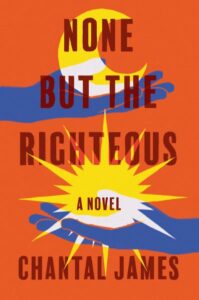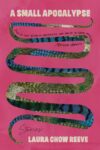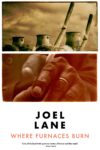
[Counterpoint Press; 2022]
How can we belong to ourselves? A climactic scene in Chantal James’s atmospheric and adroit debut novel None But the Righteous presents a clarifying if rare moment of dialogue between central characters navigating this question. In bits and pieces throughout — this fragmenting being a feature of James’s narration that keeps readers willingly if constantly searching for their footing — we learn Mayfly and Ham met each other decades before, when Ham wasn’t yet a teenager and Mayfly, just barely older than Ham, was fleeing an upbringing bent on standardizing her. Adults now, and careworn — by their individual times of riding freight trains to freedom, escaping further mortal scenes, and searching, searching for something of themselves, something of each other — Mayfly says to Ham, “I just never wanted to belong to anybody, like you never seemed to belong to anybody.” By now, the reader, joined only by the eerie and earnest presence of the narrator, one 16th century specter, the ghost of St. Martin de Porres, knows Mayfly’s interpretation of Ham is largely absurd.
Ham has been charmed, first by his prickly but concerted foster mother Miss Pearl, then by the spirit of an Afro-Peruvian Dominican monk, whose relic Miss Pearl ties around Ham’s neck when he proves beyond her willingness to possess him. Charmed here is not of the romantic kind, but conveys practices propelled by the interlaced traditions, religious as political, of the African diaspora in the Americas. Written exclusively in the voice of Porres’s spirit, the novel makes clear that Ham is not as sovereign as Mayfly believes, that Ham is more possessed by some power above, than even he can altogether register.
We meet Ham as the subject of a blessing by his sacred bone. “May Ham never wander far enough to know this,” the faithful prays, this “thirsting for the earthly body.” May Ham rest in peace, that is, whenever his day comes. Ham sits on an evening bus heading out of Atlanta, as lines turn over to his unsettled memories, his fleeting reconnection with Mayfly, his escape from the lower streets of New Orleans, as the ocean seized, the sky fell, and those who stayed risked drowning in the fervor of Hurricane Katrina, his latest but restrained involvement with Deborah, forged in those drowning streets, and back in her childhood house in rural Alabama, briefly their safe-house, before he absconded with less than a handful of mixed feelings. His earthly body intact, his mind, his memories, his spirit all swirl. Comforted, perhaps, by the fervent chant of the faithful, we readers join the spirit, hoping against what hope remains on the edges of the undone Mississippi, that Ham makes it somewhere and, like the devout “I” whose incantations have just begun, that he lets us follow him there too.
There is no stable setting or plot in None But the Righteous. We are never explicitly told that Ham is from New Orleans or that Hurricane Katrina haunts him. We are told only of “the canyons that trauma had raised in him when the storm had so brutally severed him from all he’d known.” Later, we learn Ham went to school at Our Lady of Prompt Succor, named after the patroness of Louisiana and whose several branches remain the preferred system among Catholic families across the state. Miss Pearl is introduced by way of her MeeMaw who “learned to conjure from the Indian woman whose daughter she’d saved from drowning,” and subsequently converted Miss Pearl while in springtime mayhaw forests, the ruby bayou berries deemed, by gris-gris queens and botanists alike, the jewel of Louisiana. The ambiguity spurred by the open-ended term, “Indian,” is also one especially amplified in Louisiana, where the Mardi Gras Indians are one of the largest community networks gathering in the seasonal parades, and who carry a history of complex encounter between countless Indigenous communities from the Biloxi to the Natchez peoples, and Black diasporans who were historically marooned in the swamps and up the river. Ham often refers to his fellow runaways, refugees as part of the “tribe,” but refrains from further specifics. Not knowing who the “Indian” is, is part of beginning to understand the still entangled Indigenous and Black lifeways in the region now often called Louisiana. Even if we sieve through these pieces and find Louisiana, by its blurry and fleeting references, James ensures that her novel relentlessly and thus judiciously performs the impact of “that trauma.” What is the place that is a canyon, what is the earth that is a conflagration, what kind of person finds such a site at once horror and home?
While these canyons lead to Louisiana and through Hurricane Katrina’s pummeling, the overarching project of None But the Righteous is to situate this region and its most recent catastrophic event, within a wider and longer history of canyons and of pummeling. Porres draws the connections, explaining how, of the invasion he lived amidst, by self-proclaimed conquistadors, “some worlds had met their end, others had begun, others had collided with one another,” and now, he goes on, “Ham is working under a new map himself.” Dislocation as a political policy seen from 16th century Spain is extended, almost completely unchanged, by the 21st century United States, a pattern further amplified when, for the bulk of the novel, Ham joins a group of Bolivian and Columbian migrant laborers traveling the continental southeast.
Other connections that collapse times, geographies, and traumas, linger at each others’ edges. Ham’s dreams of drowning in the tides of the hurricane bespeak ancestral realities, enslaved African peoples drowning in the middle passage, either thrown overboard in insurance ploys or set on suicide rather than withstand the belly of the boat, to say nothing of what awaits in the Americas. Indeed, Ham’s foster brother Wally, in a chance encounter late in the plot, tells of his experience in the Hurricane and recalls his shuffle “into a sports arena that had been slap-handedly converted into a mass shelter,” the New Orleans Convention Center, soon wafting “an aroma reminiscent of the hold of the Transatlantic slave ships.” Amidst his roving, Ham develops asthma, which further extends his dreams into reality, making manifest the physical debris accrued in his body, lungs specifically, from rushing through his literally shattered and rotting city. If Hurricane Katrina might be read as a consequence of climate change brought on by the capitalist fueled Anthropocene, and ever-present on-the-ground neglect by white politicians and elite residents in Lafourche to Saint Bernard parishes and nation-wide, we might regard Ham’s asthma less as singular and more a consequence of history, his reach for his inhaler painfully intimate with today’s notes of “I Can’t Breathe.”
By each of these resonances, evocative, uneasy, devastating, James sketches out the imperial histories that form the backdrop upon which virtually all the bonds across the novel are made and broken. Intriguingly, though, James keeps these references vague to the very end. The figure of St. Martin de Porres is never mentioned by name at any point (except on the summary on the back cover and it is unclear whether James wrote as much). A swallowed line here, a depiction, aslant, there, James provides just enough to point us to Porres who was the first multi-racial Dominican monk, admitted to the order only after decades of menial labor for the all-male holier-than-thou settlers who erected the mission. As relics from his robes and body continue to circulate today, he is worshipped as the divine patron of Afro-Caribbean, Afro-LatinX, Afro-American, Afro-Asian diasporas, and for unity among the dispossessed. When Porres mentions King Atahualpa, James just barely recounts his torture by Spanish captors, the promises he made to them to supply rooms full of gold, his baptism and conversion by Dominican monks, and the ultimate betrayal by the Spanish, making him the last Inca ruler of Cajamarca when the Spanish took over in 1533. The line about a “white floating flower,” renamed “lotus” by homesick settlers, similarly gestures, scarcely, towards the extractive and epistemological violences of Natural History, its agents who coerced Indigenous and African guides more knowledgeable than themselves, who harvested rare specimens to the point of depletion, who elided ancestral names, supplanting European ones through a taxonomic system still with us in Biology, Ecology, and Psychology. If you know it already, then James’s depiction of how Porres describes the Atakapa peoples barbecuing their European enemies harkens back to tropes of Indigenous peoples as cannibals that circulated across colonial literatures and that get critically repurposed by Herman Melville as the 19th century American empire pushed into Polynesia.
Filling in these details might be useful in facilitating the occasional condensation of the atmospheric here. But what James seems after is more subtle, and more political. In these rather casual gestures towards the colonial history of the Americas, James shows she knows all about it. Indeed, in previous publications, she has explored, to striking conclusion, “The Body’s Betrayal” in the midst of settlement, and how “The World Loses Its Former Shape.” As these themes shape None But the Righteous start to finish, however, they will prompt some readers to ask themselves how they’ve made it this far not knowing more about the vicious Spanish conquest, the Atlantic and Inter-American Slave Trades, the emergence and power of “hoodoo” and Vaudou and Obeah, and the complexities of Black Internationalism. It will prompt others to see what a future, when history and Critical Race Theory are studied widely, taken seriously, accepted, can look like and feel like.
Writer and critic Saidiya Hartman describes the burdened individuality carried by formerly enslaved peoples finally granted formal freedom. By burdened individuality, Hartman revises one of Western Civilization’s bedrock notions of self-possession or possessive individualism, which entails a subject’s empowerment of and responsibility for themselves and their fate, that entail, in short, their freedom. And yet, the instability in material support to facilitate decisions and negotiate possibilities, immediately burdens those previously enslaved in their emancipation; the afterlives of slavery, in this sense, repossess those who are freed but, when finally entering the world this way, possess nothing past themselves.
The route of dispossession and repossession is wayward to say the least, another notion Hartman takes up elsewhere in her work, and that James astutely works through in her novel. Dispossessed from themselves and scattered across place and in time as they are, Ham and Porres negotiate what they have left, what they have ever had, where they are going, where they have been, and who else might be with them. Asking, all the while, whether possessing dispossession is enough, Ham and Porres claim each other, they reclaim the other’s peoples, places, and sensations. By each of these exchanges, James expands the family tree, goes with the problems and possibilities of its excisions and fluidities in the wake of terror and violence. From the Inca empire to the Natchez Nation, from Peru to Louisiana, James rightly integrates Black and Indigenous histories often read as discrete or even unrelated, and suggests what solidarities might be possible across these transnational, transracial, and multilingual lines, what belongings to each other and to a place might be traced as much as made across these vexed and dynamic atmospheres. When describing the history of mapping, the effects of renaming, and the problems of reorienting, Porres adds, “The world of the son drifts exponentially away from the world of the father. No words between them can bridge the ever-widening gap.” And yet, as it happens, James’s words make this very offering.
Katrina Dzyak is a PhD Candidate in English and Comparative at Columbia University.
This post may contain affiliate links.







